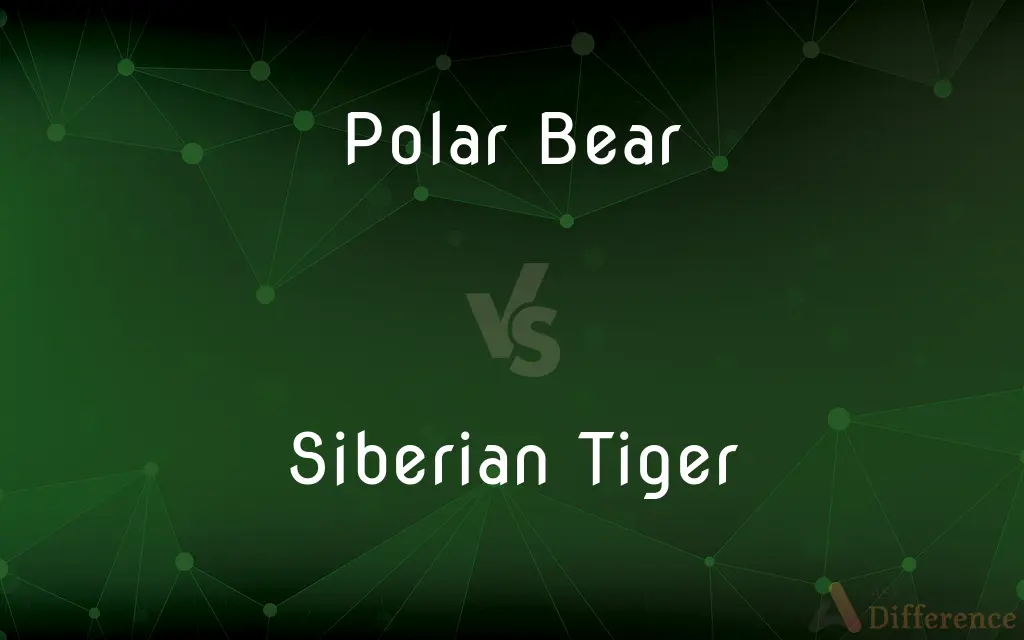Polar Bear vs. Siberian Tiger — What's the Difference?
By Tayyaba Rehman & Fiza Rafique — Published on October 11, 2023
Polar bears are large carnivores native to the Arctic region, while Siberian tigers are big cats found in the Siberian forests.

Difference Between Polar Bear and Siberian Tiger
Table of Contents
ADVERTISEMENT
Key Differences
Polar Bear vs. Siberian Tiger in Habitat:
Polar bears predominantly inhabit the sea ice of the Arctic Ocean. They are well-adapted to cold environments. Siberian tigers, on the other hand, reside in the dense forests of eastern Russia and parts of China, where the climate can range from cold in winters to moderate in summers.
Polar Bear vs. Siberian Tiger in Physical Appearance:
Polar bears have a thick layer of body fat and dense fur to insulate them from the cold. Their white fur provides camouflage against the snow. Siberian tigers boast a beautiful orange coat with black stripes, enabling them to blend seamlessly into their forested surroundings.
Polar Bear vs. Siberian Tiger in Diet:
ADVERTISEMENT
Polar bears mainly feed on seals, relying on the fat for sustenance. Their primary hunting method is stalking seals on the ice. Siberian tigers are apex predators, feeding primarily on ungulates like deer and wild boar but can also hunt smaller animals or even bears.
Polar Bear vs. Siberian Tiger in Size and Strength:
Polar bears are among the largest carnivores on land, with males weighing up to 1,500 pounds. They have powerful limbs which assist in swimming. Siberian tigers, while the largest of the tiger subspecies, weigh up to 660 pounds for males. Their strength lies in their powerful build and agility.
Polar Bear vs. Siberian Tiger in Conservation:
Both polar bears and Siberian tigers face threats from habitat loss and climate change. While polar bears grapple with melting ice, Siberian tigers confront habitat fragmentation and poaching.
Comparison Chart
Habitat
Arctic sea ice
Siberian forests
Color
White
Orange with black stripes
Primary Diet
Seals
Deer, wild boar
Weight
Up to 1,500 pounds (male)
Up to 660 pounds (male)
Conservation Status
Vulnerable due to melting ice
Endangered due to poaching & habitat loss
Compare with Definitions
Polar Bear
A large white carnivore native to the Arctic region.
The polar bear prowled the icy landscape, searching for seals.
Siberian Tiger
An apex predator feeding on a variety of mammals.
The Siberian tiger stealthily stalked its prey, a deer grazing in the distance.
Polar Bear
A species facing threats from global warming and habitat loss.
Conservationists are working diligently to protect the polar bear and its habitat.
Siberian Tiger
The largest of all tiger subspecies, known for its orange coat with black stripes.
The coat of the Siberian tiger allows it to blend effortlessly into its surroundings.
Polar Bear
A marine mammal skilled in swimming and hunting on ice.
Despite its size, the polar bear can swim for long distances without tiring.
Siberian Tiger
A large cat species native to the forests of Siberia.
The Siberian tiger is a majestic sight, roaming the dense woods of eastern Russia.
Polar Bear
A symbol of the Arctic and a figurehead for climate change awareness.
The declining polar bear population is a stark reminder of the impacts of global warming.
Siberian Tiger
A symbol of strength and power in various cultures.
In folklore, the Siberian tiger is often revered for its might and grace.
Polar Bear
An apex predator primarily feeding on seals.
The primary diet of a polar bear consists of fatty seals.
Siberian Tiger
A species threatened by habitat loss and poaching.
Conservation efforts are ongoing to save the Siberian tiger from extinction.
Common Curiosities
What is the main diet of a Siberian tiger?
Siberian tigers mainly feed on deer and wild boar.
Where is the polar bear's natural habitat?
Polar bears primarily inhabit the Arctic sea ice.
How are polar bears adapted to cold environments?
They have thick body fat and dense fur for insulation.
How big can Siberian tigers get?
Males can weigh up to 660 pounds.
How do polar bears hunt their prey?
They mainly stalk seals on ice.
Are polar bears good swimmers?
Yes, they are skilled swimmers and can cover long distances.
What color is a polar bear's skin?
It's black underneath their white fur.
Are Siberian tigers the largest tiger subspecies?
Yes, they are the largest among all tiger subspecies.
How is climate change affecting polar bears?
Melting sea ice threatens their habitat and hunting patterns.
Do Siberian tigers live in groups?
No, they are generally solitary animals.
Why are Siberian tigers endangered?
Due to poaching and habitat loss.
Are both polar bears and Siberian tigers apex predators?
Yes, both are at the top of their respective food chains.
How fast can a Siberian tiger run?
They can reach speeds up to 50-60 mph in short bursts.
Do polar bears have any natural predators?
Adult polar bears have no natural predators, but cubs can be preyed upon by other carnivores.
What regions do Siberian tigers inhabit?
They are found in the forests of eastern Russia and parts of China.
Share Your Discovery

Previous Comparison
Santa Claus vs. Sinterklaas
Next Comparison
Word vs. MorphemeAuthor Spotlight
Written by
Tayyaba RehmanTayyaba Rehman is a distinguished writer, currently serving as a primary contributor to askdifference.com. As a researcher in semantics and etymology, Tayyaba's passion for the complexity of languages and their distinctions has found a perfect home on the platform. Tayyaba delves into the intricacies of language, distinguishing between commonly confused words and phrases, thereby providing clarity for readers worldwide.
Co-written by
Fiza RafiqueFiza Rafique is a skilled content writer at AskDifference.com, where she meticulously refines and enhances written pieces. Drawing from her vast editorial expertise, Fiza ensures clarity, accuracy, and precision in every article. Passionate about language, she continually seeks to elevate the quality of content for readers worldwide.















































